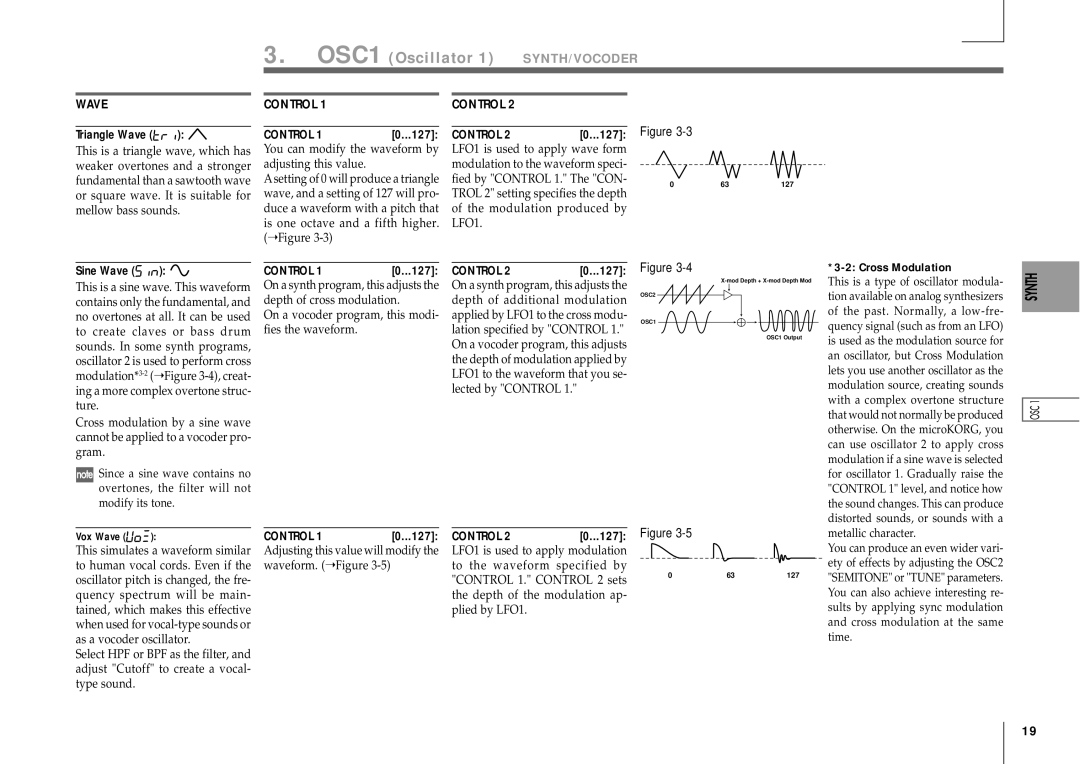
3.OSC1 (Oscillator 1) — SYNTH/VOCODER
WAVE
Triangle Wave (



 ):
): 
This is a triangle wave, which has weaker overtones and a stronger fundamental than a sawtooth wave or square wave. It is suitable for mellow bass sounds.
CONTROL 1
CONTROL 1 | [0...127]: |
You can modify the waveform by adjusting this value.
A setting of 0 will produce a triangle wave, and a setting of 127 will pro- duce a waveform with a pitch that is one octave and a fifth higher. (➝ Figure
CONTROL 2
CONTROL 2 | [0...127]: |
LFO1 is used to apply wave form modulation to the waveform speci- fied by "CONTROL 1." The "CON- TROL 2" setting specifies the depth of the modulation produced by LFO1.
Figure
0
Sine Wave (



 ):
): 
This is a sine wave. This waveform contains only the fundamental, and no overtones at all. It can be used to create claves or bass drum sounds. In some synth programs, oscillator 2 is used to perform cross
Cross modulation by a sine wave cannot be applied to a vocoder pro- gram.
![]() Since a sine wave contains no overtones, the filter will not modify its tone.
Since a sine wave contains no overtones, the filter will not modify its tone.
Vox Wave (![]()
![]()
![]()
![]()
![]()
![]() ):
):
This simulates a waveform similar to human vocal cords. Even if the oscillator pitch is changed, the fre- quency spectrum will be main- tained, which makes this effective when used for
Select HPF or BPF as the filter, and adjust "Cutoff" to create a vocal- type sound.
CONTROL 1 | [0...127]: |
On a synth program, this adjusts the depth of cross modulation.
On a vocoder program, this modi- fies the waveform.
CONTROL 1 | [0...127]: |
Adjusting this value will modify the waveform. (➝ Figure 3-5)
CONTROL 2 | [0...127]: |
On a synth program, this adjusts the depth of additional modulation applied by LFO1 to the cross modu- lation specified by "CONTROL 1." On a vocoder program, this adjusts the depth of modulation applied by LFO1 to the waveform that you se- lected by "CONTROL 1."
CONTROL 2 | [0...127]: |
LFO1 is used to apply modulation to the waveform specified by "CONTROL 1." CONTROL 2 sets the depth of the modulation ap- plied by LFO1.
Figure |
|
|
|
|
|
|
| |
|
| This is a type of oscillator modula- | ||||||
|
|
|
|
|
|
|
| |
OSC2 |
|
|
|
|
|
| tion available on analog synthesizers | |
|
|
|
|
|
|
|
| |
|
|
|
|
|
|
|
| of the past. Normally, a |
OSC1 |
|
|
|
|
|
|
| quency signal (such as from an LFO) |
|
|
|
|
|
|
| ||
|
|
|
|
|
|
|
| |
|
|
|
|
|
|
| OSC1 Output | is used as the modulation source for |
|
|
|
|
|
|
|
| |
|
|
|
|
|
|
|
| an oscillator, but Cross Modulation |
|
|
|
|
|
|
|
| lets you use another oscillator as the |
|
|
|
|
|
|
|
| modulation source, creating sounds |
|
|
|
|
|
|
|
| with a complex overtone structure |
|
|
|
|
|
|
|
| that would not normally be produced |
|
|
|
|
|
|
|
| otherwise. On the microKORG, you |
|
|
|
|
|
|
|
| can use oscillator 2 to apply cross |
|
|
|
|
|
|
|
| modulation if a sine wave is selected |
|
|
|
|
|
|
|
| for oscillator 1. Gradually raise the |
|
|
|
|
|
|
|
| "CONTROL 1" level, and notice how |
|
|
|
|
|
|
|
| the sound changes. This can produce |
Figure |
|
|
|
|
|
| distorted sounds, or sounds with a | |
|
|
|
|
|
| metallic character. | ||
|
|
|
|
|
|
|
| You can produce an even wider vari- |
|
|
|
|
|
|
|
| ety of effects by adjusting the OSC2 |
0 | 63 |
|
| 127 | "SEMITONE" or "TUNE" parameters. | |||
|
|
|
|
|
|
|
| |
You can also achieve interesting re- sults by applying sync modulation and cross modulation at the same time.
19
